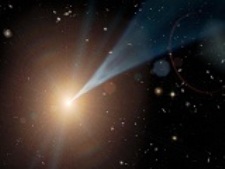Apr 25 2013
Blazars are the brightest of active galactic nuclei, and many emit very high-energy gamma rays. New observations of a blazar known as PKS 1424+240 show that it is the most-distant known source of very high-energy gamma rays. But its emission spectrum appears highly unusual.
 Artist's conception of a blazar. Courtesy of NASA/JPL-Caltech.
Artist's conception of a blazar. Courtesy of NASA/JPL-Caltech.
A team including Carnegie's Michele Fumagalli used data from the Hubble Space Telescope to set a lower limit for the blazar's redshift (z ≥ 0.6035). An object's redshift value is a measurement of how much the wavelength of the light from it that reaches Earth is stretched by the expansion of the Universe. Thus, it reveals the object's age and distance. This blazar's redshift corresponds to a distance of at least 7.4 billion light-years. Their work will be published by The Astrophysical Journal and is available online.
Over such a great distance, a substantial proportion of the gamma rays should be absorbed by the extragalactic background light, but calculations that account for the expected absorption yield an unexpected emission spectrum for the blazar.
"We're seeing an extraordinarily bright source that does not display the characteristic emission expected from a very high-energy blazar," said lead author Amy Furniss, University of California Santa Cruz.
The findings may indicate something new about the emission mechanisms of blazars, the extragalactic background light, or the propagation of gamma-ray photons over long distances. It was not thought that such high-energy gamma-ray sources could be seen at such great distances. The research should allow scientists to better understand cosmological models that predict the extragalactic background light.
The extragalactic background light (EBL) is the diffuse radiation from all stars and galaxies, a dim but pervasive glow that fills the universe. When a high-energy gamma-ray photon collides with a lower-energy EBL photon, they annihilate and create an electron-positron pair. The farther gamma rays have to travel, the more likely they are to be absorbed by this mechanism. This limits the distance to which sources of very high-energy gamma rays can be detected.
Measuring the EBL directly is extremely difficult because there are so many bright sources of light in our immediate neighborhood. In addition to estimates based on cosmological models, astronomers have used galaxy counts to set a lower limit for the EBL. Using a model close to this lower limit to calculate the expected absorption of very high-energy gamma rays from PKS 1424+240, the team derived an intrinsic gamma-ray emission spectrum for the blazar. The results, however, deviate from the expected emission based on current blazar models, which are thought to result from a relativistic jet of particles powered by matter falling onto a supermassive black hole at the center of the host galaxy.
Gamma rays from PKS 1424+240 were first detected by the Fermi Gamma-ray Space Telescope and subsequently by the ground-based instrument VERITAS (Very Energetic Radiation Imaging Telescope Array System), which is sensitive to gamma-rays in the very high-energy (VHE) band from about 100 GeV to more than 10 TeV. To determine the redshift of the blazar--a measure of how much the light from an object has been stretched to longer wavelengths by the expansion of the universe--the researchers used archival data obtained by the Hubble Space Telescope.